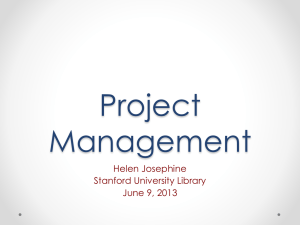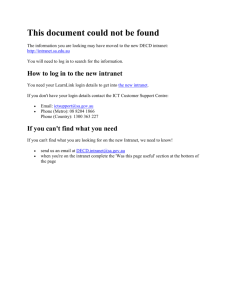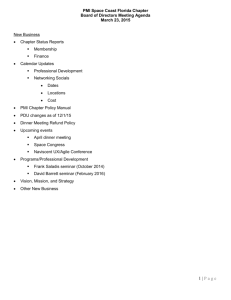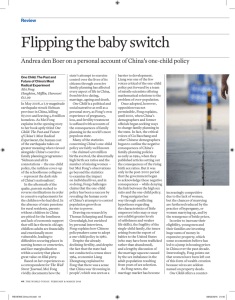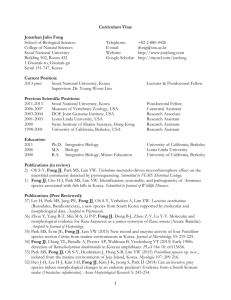Communication Good Practices in High Technology Projects
advertisement
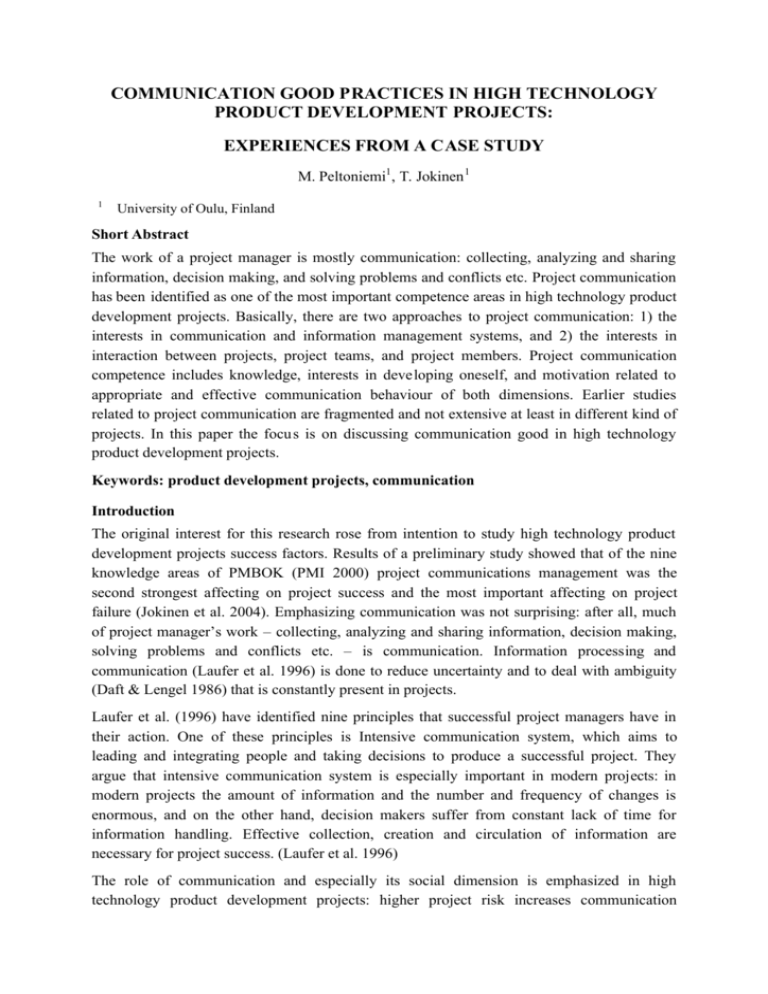
COMMUNICATION GOOD PRACTICES IN HIGH TECHNOLOGY PRODUCT DEVELOPMENT PROJECTS: EXPERIENCES FROM A CASE STUDY M. Peltoniemi1, T. Jokinen 1 1 University of Oulu, Finland Short Abstract The work of a project manager is mostly communication: collecting, analyzing and sharing information, decision making, and solving problems and conflicts etc. Project communication has been identified as one of the most important competence areas in high technology product development projects. Basically, there are two approaches to project communication: 1) the interests in communication and information management systems, and 2) the interests in interaction between projects, project teams, and project members. Project communication competence includes knowledge, interests in developing oneself, and motivation related to appropriate and effective communication behaviour of both dimensions. Earlier studies related to project communication are fragmented and not extensive at least in different kind of projects. In this paper the focus is on discussing communication good in high technology product development projects. Keywords: product development projects, communication Introduction The original interest for this research rose from intention to study high technology product development projects success factors. Results of a preliminary study showed that of the nine knowledge areas of PMBOK (PMI 2000) project communications management was the second strongest affecting on project success and the most important affecting on project failure (Jokinen et al. 2004). Emphasizing communication was not surprising: after all, much of project manager’s work – collecting, analyzing and sharing information, decision making, solving problems and conflicts etc. – is communication. Information processing and communication (Laufer et al. 1996) is done to reduce uncertainty and to deal with ambiguity (Daft & Lengel 1986) that is constantly present in projects. Laufer et al. (1996) have identified nine principles that successful project managers have in their action. One of these principles is Intensive communication system, which aims to leading and integrating people and taking decisions to produce a successful project. They argue that intensive communication system is especially important in modern projects: in modern projects the amount of information and the number and frequency of changes is enormous, and on the other hand, decision makers suffer from constant lack of time for information handling. Effective collection, creation and circulation of information are necessary for project success. (Laufer et al. 1996) The role of communication and especially its social dimension is emphasized in high technology product development projects: higher project risk increases communication frequency and the need for face-to-face conversation while decreasing the preference for written reports (Müller 2003). Project management literature and research has approached especially the benefits of different information systems and applications. Also, certain aspects of communication as a means of leadership have been approached. On the other hand Thomas et al (1999) have introduced a questionnaire to monitor communication in construction projects. The purpose of this paper is to discuss about good communication practices especially in high technology product development projects. Project communication Project communication has been divided to intra-project communications and extra-project communications. Intra-project communications includes communication flows between members of a project team. Extra-project communications includes communication flows between project team members and outside sources. (Lievens & Moenaert 2000, II) Project communications can be also divided to (Burke 1999): § formal vs. informal. Formal communication refers to management of explicit information flows. It includes e.g. documentation, reports, memos, minutes, specifications etc (Burke 2001). § written vs. verbal vs. nonverbal (e.g. body language). See e.g. Brilhart & Galanes 1995 § planned vs. ad-hoc Project communications management is required to ensure timely and appropriate generation, collection, dissemination, storage, and ultimate disposition of project information. It provides the critical links among people, ideas and information that are necessary for success. Everyone involved in the project must be prepared to send and receive communications in the project 'language'. Everyone must also understand how the communication they are involved in as individuals affect the project as a whole. (PMI 2000) According to PMI (2000) Project communications management includes four processes: 1. Communications planning process involves mainly stakeholder analysis. Inputs to this process are communications requirements, communications technology, constrains and assumptions. As an output of this project communications management plan is delivered. 2. Information distribution process is about delivering project records, project reports and project presentations. Inputs to this process are work results, communications management plan and project plan. As tools and techniques in this process communication skills, information retrieval systems and information distribution methods are used. 3. Project plan, work results and other project results are inputs to performance reporting process. In this process following tools and techniques may be used: performance reviews, variance analysis, trend analysis, earned value analysis, information distribution tools and techniques. Outputs of performance reporting process are performance reports and change request. 4. By administrative closure process project archives, project closure and lessons learned are achieved. Inputs to this process are performance measurement documentation, product documentation and other project records. Process is accomplished by performance reporting tools and techniques, project reports and project presentations. PMI’s definition about project communication management refers both intra- and extraproject communication emphasizing information processing. Contrast to this, Brilhart and Galanes (1995) highlight interaction between people and define communication as a process by which people create and send signals that are received, interpreted, and responded to by other people. They state that there are five principles related to communication. First, human communication is symbolic, which means that people send messages that need to be interpreted. Signals that people exchange are signs (nonverbal elements like tone of voice) and symbols (signals created by humans to represent experiences, objects, or concepts, e.g. we call pen the thing we write). Second, communication is personal, which means that signal will have different association in sender and in receiver. Thirdly, communication is transactional process meaning that participants need to cooperate in order to achieve mutual understanding and that communication is an ongoing event. Fourth, communication is not always intentional referring that in a group you can not NOT to communicate, your message may be interpreted wrong and that people do not always know what they intend. Fifth principle declares that communication involves content (the subject of the message), relationship (how speaker views his/her relationship to other participants), an d affective levels (how speaker feels about what he/she is saying). (Brilhart and Galanes 1995) In order to communicate effectively with other people in project team good communication competence is needed. Rubin (1990) states: “communication competence is a knowledge about appropriate and effective communication behaviours, development of a repertoire of skills that encompass both appropriate and effective means of communicating, and motivation to behave in ways that are viewed as both appropriate and effe ctive by interactants”. Different communication contexts (Infante et al. 1993) are all to be considered separately the project environment: interpersonal (between two people, e.g. Brilhart and Galanes 1995), small group (involving several people, e.g. Brilhart and Galanes 1995), organizational (within and between organizations, e.g. Wiio 1979, Andrews & Herschel 1996), public (one addressing larger audience), mass (communication mediated by electronic or print media), and intercultural (between people of different cultures, e.g. Loosemore and Muslmani 1999, Loosemore and Lee 2002). Intercultural communication is in many ways far more complicated (e.g. language, gestures) because participants need to be aware of increased potential of misunderstanding (Brilhart and Galanes 1995). Besides cultural differences between organizations, project team members are typically part of different subcultures. Thus, in a new project team there may be communication problems because of differences in languages and expressions in different professions (Koskinen et al., 2003). When speaking of communication, an interesting debate relates to knowledge management: in communication both sending and receiving signals are based on individuals’ knowledge and experiences (Ross & Ross 1982). One frame of knowledge management research stresses the role of tacit knowledge: knowledge can not be easily shared or transferred; it is embedded in specific social context and created by the individual in a situation of interaction (e.g. Koskinen et al. 2003, Fernie et al. 2003). Research of information management system is highly relevant for project communication research: data management systems are way of storing and transmitting explicit knowledge. According to Hall & Sapsed (2005) KM systems include information technology (IT), internal governance mechanism, organizational culture and incentive schemes. Liebowitz (2005) argues that technology is used “as an enabler for sharing the knowledge”: the true core of the matter consists of people and processes. Efficiency and effectiveness of KM systems depends upon organizational roles, structure, and culture, reward system, and industry dynamics (Hall & Sapsed 2005). Compared to traditional process industry, organizational structure and knowledge-absorbing routines that support knowledge transfer are nearly non-existent in project environment. Thus knowledge sharing and transmitting is not as easy in project environments as in traditional process industry. (Fong 2005). The case project In this chapter, first, the empirical part of the research is presented in general, and then the case company and case program are introduced. Finally, the results of the empirical part are presented. In the empirical part of the study a product development program (basically a large project, about 150 man years) was chosen to be studied closely in this study. First, open interviews were conducted in order to identify selected variables about the case program and the company that it belongs to. Then, a questionnaire was send to every case program member. The case program belongs to a company operating in telecommunication industry. The company has over twenty years experience of project work. About 65% of the personnel is working in R&D concentrating on development of company’s own products. There has been number of activities for project communication development in the company for several years. For example, all ready in 1999 company had documents describing what is meant by project communication, why special attention to project communication is important, different roles and information needs in project communication, difficulties in project communication, and guidelines for communication in different project situations. The company has a process description and guidelines for program communication management. There are also guidelines for general data management concerning data management tools and their usage. Project communication plan is recommended to be accomplished in every program. There are also several questionnaires at different levels for e.g. monitoring the effectiveness of communication. In general, the case program is a large SW product development project typical for the company. The programs in the case organization are typically very complex, as is the ca se program too. The case program is release based development i.e. the outcome has unique features but truly is an improvement version of existing product. Total duration of the program is about 2 years. Program personnel are diversified from their cultural background. The program has personnel in many locations in Finland and in nationally. There are also a number of subcontractors involved in the case program. Organization design affects on communication effectiveness: the more complex and formalized the organization the more intraproject communication and, on the other hand, the more there is centralization the less there is communication within project team. (Lievens & Moenaert 2000b). The R&D personnel of the company are organized as a matrix. Organization chart of the case program is presented in figure 1. Program management team Program manager Program assistant Program advisor Supporting functions, e.g. - Configurations management, - Communications - etc Projects: • Project 1 • Sub -project 1 • Sub -project 2 • Sub -project 3 • etc. Figure 1: General organization chart of the case program. The main communication media in the case program is intranet. Also email and phone are used generally. In intranet, a program newsletter is published once a month and there is also a possibility for sending questions to program management via intranet. The case program uses program data management system for managing all program documents. Plus to this, there is a specific data management system for managing SW codes used by all SW programs. Questionnaire and analysis of the results The questionnaire form was sent to 269 respondents of which 117 fulfilled the form. The respondent rate was 43,5%. Most of the questionnaire questions considered a certain topic from two different point of views: 1. respondents satisfaction with the current practice, and 2. respondents view of the importance of the practice. The top 10 current statuses are presented in table 1 and top 10 well-managed practices in table 2. Score 1 2 3 4 5 6 7 8 9 10 Question Understanding your roles and responsibilities Understanding what is expected from you Team spirit in your team Knowing how your job affects on your project success Access to people with information necessary to you Knowing from who or where to get the information you need Communication in your project team Communication by email Access to information necessary to you Understanding how the project relates to other projects Mean 5,53 5,43 5,38 5,34 5,19 5,06 5,03 4,91 4,82 4,82 Table 1. Top 10 means for currents statuses. Well-managed practices are those which respondents are at least as satisfied as they consider the issue is important. Table 2 presents the TOP 10 well-managed issues, i.e. the issues that derive least when considering the importance of the practice and satisfaction for the current practice (importance-value minus currents status-value). Score 1 2 3 4 5 6 7 8 9 10 Question Understanding what is expected from you Understanding your roles and responsibilities Communication by phone Knowing how your job affects on your project success Program intranet pages Project intranet pages Program info sessions Team spirit in your team Communication planning Communication between team and program manager Difference of means 0,23 0,43 0,48 0,53 0,54 0,63 0,64 0,69 0,76 0,78 Table 2. Top 10 well-managed practices. The questionnaire form included also following free-text questions: 1. Current good practices in project communication? 2. What communication practices should be avoided? 3. How could communications be improved? Most often mentioned communication good practices are (N= 63) meetings and info sessions, email, and open and honest communication. Most often mentioned communication practices to be avoided are (N= 43) email and meetings and info sessions. Topics that come up from the results for question how to improve project communication (N= 46) are communication roles and responsibilities including boundary spanning communication (12), different kind of meetings and happenings (12), communication quality (10), communication tools (7), communication of changes (5). The results show that the case personnel are satisfied for how well they understand the overall picture of the project they are involved and their own roles and responsibilities in it. This is due to effective communication via different media: § relevant program level business information is shared in program infos regularly § communication is planned in the program § intranet pages provide easy access to all relevant information of the program and projects § enough attention is paid to building team spirit, e.g. in program kick off and during the program Different meetings are an essential communication medias. The problems related to meetings concern target group, roles, and scope and topic of the meeting. Also, certain project members have too many meetings. The principles of effective meetings have been defined but not fully implemented. The principles include e.g.: § the purpose, agenda and participants of the meeting are considered before hand § everyone prepares for the meeting § for some meetings the agenda is tightly scheduled, so that persons can participate only when necessary § meeting minutes are well documented and delivered, and made decisions are highlighted Email important communication media but project members receive too many emails daily. Thus, actions have been made to reduce the amount of emails. The high risky business and complex organization impose communication on very important position. The results show that not only the time for communication is limited but also totally insufficient in such a large and complex project as the case project. As Amami & Beghini (2000) stated, there is a need to separate flows with useful information from those that only generate noise. Several means for this were identified from the case: § Generating guidelines for good practices related e.g. to email, making memos etc. § Paying attention to that everyone understands the overall situation and thus is able to operate in a problematic situation § Paying attention to informativeness of documents (this result is also supported by the arguments by Abdomerovic et al. 2003) § Developing and utilizing a project communication plan Also, the results support findings by Mohamed & Steward (2003): while internet based tools have positive impact on e.g. document transfer and handling, enhanced coordination and communication between project parties and reduced response time to answer queries, the effective use of them requires proper training and support throughout implementation. Moreover, despite of all the good results of using electronic and internet based tools they can never be substitutes for human contact: communication is about transmitting and coordinating information but also to interpreting, eliminating equivocation, and to generate new ideas, as stated by Laufer et al. 1996. In the case organization there are guidelines e.g. for effective use of email and meetings practices but still these issues are considered as problematic. It seems that just a guideline is not enough, personnel has to be trained to e.g. use a tool in a right way. Also AmoakoGyampah and Salam (2003) highlighted the importance of training and communication because they influence on shared beliefs. Utilizing project communication plan is not very common. In the case organization project communication plan was recommended. The development of a project communication plan followed structure suggested by Saia (1999): 1. Identify the audience and its communication needs (cf. communications planning, performance reporting, and administrative closure processes defined by PMI 2000), 2. Identify the most effective methods for communicating to the audience (cf. information distribution process defined by PMI 2000), and 3. Identify who should deliver the message. Discussion It seems that in very complex project environment the need for communication is immense, but the time for it is limited (working hours are not sufficient). Thus, based on the findings, it is recommended to treat communication as any other project resource: plan, control and follow up the effectiveness and efficiency of communication. Means for that are guidelines for different communication situations and tools, project communication plan and different kind of questionnaires at different levels on the organization. Electronic and internet based tools enhance communication in many ways, but the organization must pay attention to proper training of them. Based on the results also training of personal communication skills is recommended. In general, implementing different processes and guidelines is not happening easily. Understanding overall picture of the project one is involved motivates and makes it easier to operate problematic situations. Good ways of sharing information are meetings, infos, intranet pages, newsletter etc. Building an open communication culture should be supported. In this paper a in-depth study of a case project has been described. To generalize the results, the research would benefit from more case studies of different kinds (e.g. small, medium) of high technology product development projects. To say, it can be that the communication in general, for example, is culturally dependent and thus unique in every company and every project. At least, Lievens & Moenaert (2000) state that communications effectiveness is a function of matching communication patterns to the nature of the project team task. REFERENCES 1. Amami M., Beghini G. 2000. Project management and communication of product development through electronic document management. Project Management Journal, 31, pp. 6-19. 2. Amoako-Gyampah, K. and A. F. Salam (2003). An extension of the technology acceptance model in an ERP implementation environment. Information & Management 3. Andrews P H & Baird J R Jr. 1995. Communication for Business and the Professions. (6th Ed.). Brown & Benchmark PublishersDubuque, IA. 4. Brilhart J. K., Galanes G. J. 1995. Effective Group Discussion. Wm. C. Brown Communications, Inc., Dubuque. 5. Burke R. 2001. Project management. Planning and control techniques. John Wiley & Sons Ltd, Chichester. 6. Daft R. L., Lengel R. H. 1986. Organizational information requirements, media richness and structural design. Management Science, 32, 554-572. 7. Fernie S., Green S. D., Weller S. J., Newcombe R., 2003. Knowledge sharing: context, confusion and controversy. International Journal of Project Management, 21, pp. 177-187 8. Fong P S W (2005). Managing knowledge in project-based professional services firms. IN: Love P E D, Fong P S W & Irani Z (Ed.). Management of knowlede in project environments. Elsevier Butterworth-Heinemann. p 103-154. 9. Hall J & Sapsed J (2005) Influence of knowledge sharing and hoarding in project -based firms. IN: Love P E D, Fong P S W & Irani Z (Ed.). Management of knowlede in project environments. Elsevier Butterworth-Heinemann. p 57-80. 10. Infante D. A., Rancer A. S., Womack D. F., 1997. Building communication theory. Waveland Press, Inc., Prospect Heights 11. Jokinen T., Peltoniemi M., Karivalo P. 2004 Critical Success Factors in High Technology Projects. Project Perspectives, March 2004. 12. Koskinen K. U., Pihlanto P., Vanharanta H., 2003. Tacit knowledge acquisition and sharing in a project work context. International Journal of Project Management, 21, pp. 281-290 13. Laufer A., Denker G. R., Shenhar A. J. 1996. Simultaneous management: the key to excellence in capital projects. International Journal of Project Management, 14, 189-199. 14. Liebowitz J (2005) Conceptualizing and implementing knowledge management. IN: Love P E D, Fong P S W & Irani Z (Ed.). Management of knowlede in project environments. Elsevier Butterworth-Heinemann. p 1-18. 15. Lievens A., Moenaert R. K. 2000b. New service teams as information-processing systems: Reducing innovative uncertainty. Journal of Service Research, 3, 46-66. 16. Loosemore M., Lee P., 2002. Communication problems with ethnic minorities in the construction industry. International Journal of Project Management, 20, pp. 517-524 17. Loosemore M., Muslmani H. S. A., 1999. Construction project management in the Persian Gulf: inter-cultural communication. International Journal of Project Management. 17, pp. 95-100 18. Mohamed, S. and R. A. Steward (2003). An empirical investigation of users' per-ceptions of webbased communication on a construction project. Automa-tion in Construction, 12, 43-53. 19. Müller R. 2003. determinants for external communications of IT project managers. International Journal of Project Management, 21, pp. 345-354. 20. PMI. 2000. A Guide to the Project Management Body of Knowledge, Maryland USA, Project Management Institute, 176 p. 21. Ross R. S., Ross M. G., 1982. Relating and interacting. An introduction to interpersonal communication. Prentice-Hall, Inc., Englewood Cliffs 22. Rubin R.B., 1990. Communication competence. In G.M. Phillips and J.T. Wood (Ed.) Speech communication: Essays to commemorate the 75th anniversary of the Speech Communication Association. Carbondale: Southern Illinois University Press, 94-129 23. Saia R. 1999. One project, one voice. Compurterworld, 33, 62. 24. Thomas S R, Tucker R L, Kelly W R. 1999. Compass: An assessment tool for improving project team communications. Project Management Journal, Vol. 30, iss. 4, 15-25. 25. Wiio O. A. 1979. Contingencies of organizational communication. The Helsinki School of Economics, B-30.



